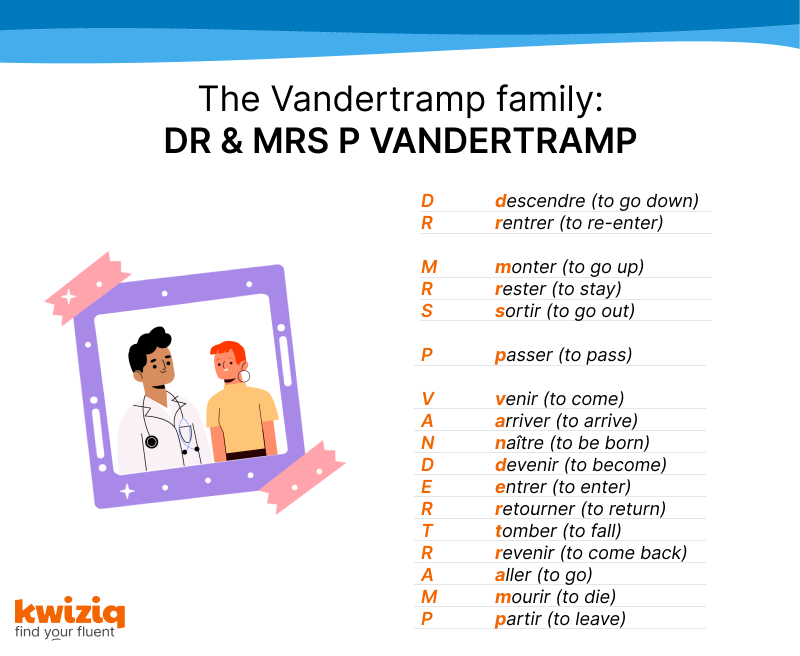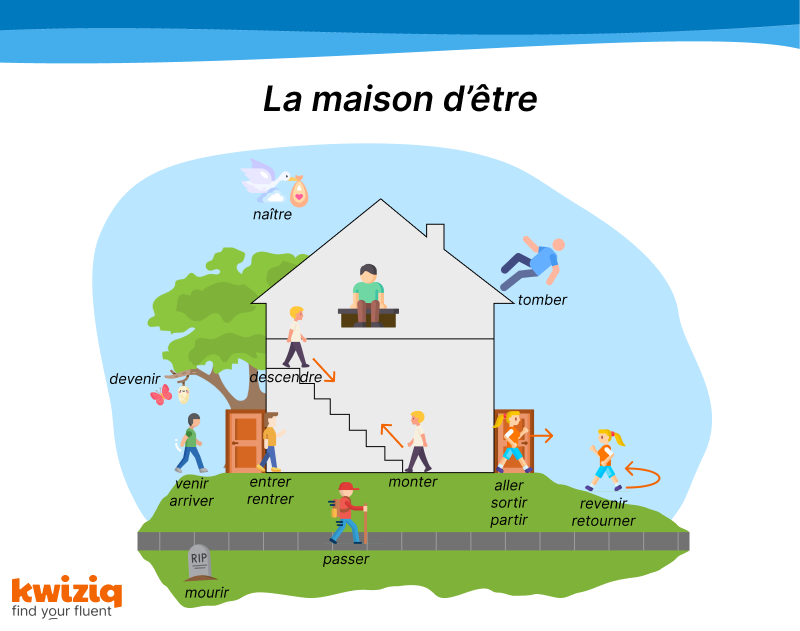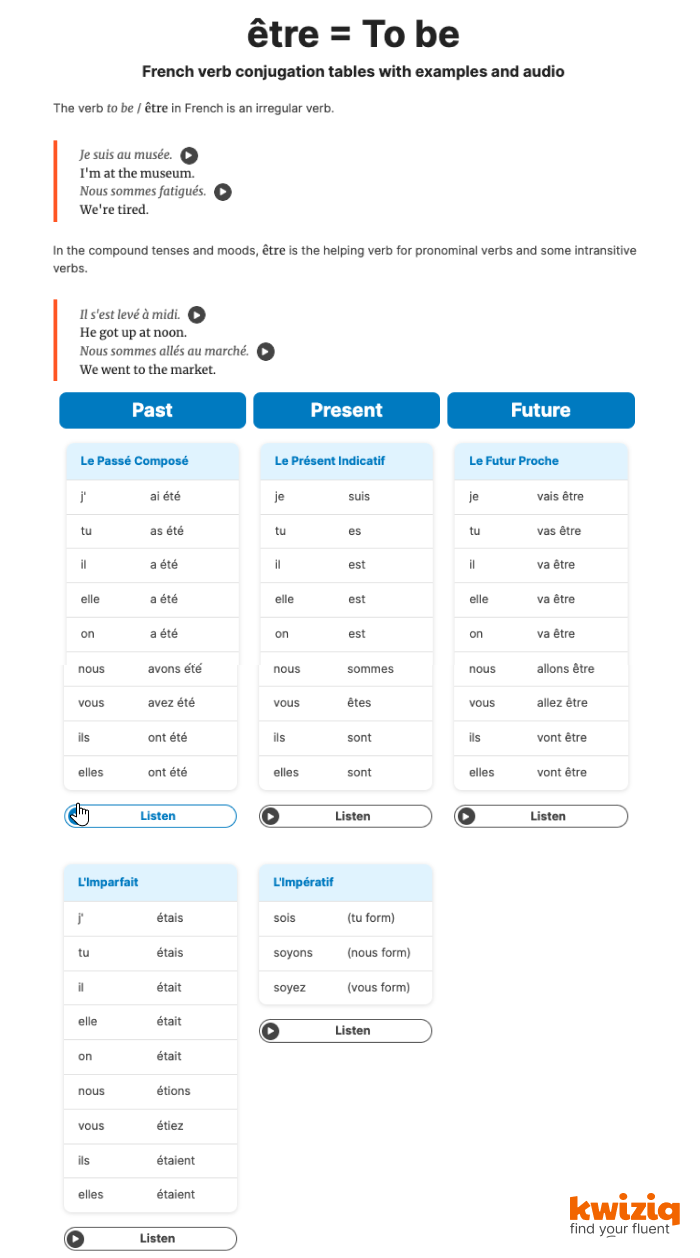Table of Contents
- “Être” and “Avoir” Meaning - To Be or To Have?
- When the French Verb "Avoir" Means “To Be” in English
- Idiomatic Expressions with the French Verb “Avoir”
- Idiomatic Expressions with the French Verb "Être"
- “Être” and “Avoir” as Auxiliary Verbs in French
- The French Verb "Être" and the Passive Voice
- 3 Ways to Practise Using the French Verbs "Être" and "Avoir"
Now that you’ve mastered the basics of French verb conjugation, concepts like French infinitives, verb conjugation groups and verb conjugation tables have no more secrets for you, so it’s time to focus your attention on the most ubiquitous (and, of course, the most irregular) verbs of the French language: "être" and "avoir".
In this page, you’ll learn when and how to use the French verbs "être" and "avoir", their meanings and different functions, as well as how to conjugate them in Le Présent, which is also useful to talk about the past, as you will see.
“Être” and “Avoir” Meaning - To Be or To Have?
Let’s start with the simplest meanings of both verbs. In a nutshell, "être" means “to be” and "avoir" means “to have”:
J’ai un frère et une sœur.
I have a brother and a sister.
Ma prof est très intéressante.
My teacher is very interesting.
But of course, there are always differences between languages.
Have a look at a few French expressions where we use "avoir" in French while English uses “to be”.
When the French Verb "Avoir" Means “To Be” in English
To express one’s age in French, you don’t say “I am X years old”, but literally “I have X years”:
I am thirty-two years old.
To say “I am hungry/thirsty” in French, you literally say “I have hunger/thirst”:
J’ai faim.
I am hungry.
Les enfants ont un peu soif.
The children are a bit thirsty.
To say “I am cold/hot” in French, you literally say “I have cold/hot”:
J’ai très froid.
I am very cold.
Ma cousine a toujours chaud.
My cousin is always hot.
To say “I am right/wrong” in French, you use avoir raison or tort:
J’ai toujours raison.
I’m always right.
Il n’aime pas avoir tort.
He doesn’t like being wrong.
To say “I am scared/afraid” in French, you literally say “I have fear”:
I am scared of spiders.
To say “I am lucky” in French, you literally say “I have (some) luck”:
J’ai souvent de la chance.
I’m often lucky.
Donald Duck n’a jamais de chance !
Donald Duck is never lucky!
To say “there is/there are” in French, you use the expression il y a, literally “It has there”:
Dans le parc, il y a une balançoire.
In the park, there is a swing.
Il y a de bonnes soldes en ce moment.
There are good sales at the moment.
There are also French idiomatic expressions using either "avoir" or "être", with completely different English translations. Here are some of the most common and useful ones:
Idiomatic Expressions with French verb "avoir"
This French expression, literally “to have envy/want of”, means “to want/to feel like [something]” in French:
J’ai toujours envie de dormir.
I always want to sleep/I always feel sleepy.
Qui a envie d’un couscous ?
Who feels like couscous?
This French expression, literally “to have need of”, means “to need (to do) [something]” in French:
J’ai besoin de toi.
I need you.
Vous avez besoin de pratiquer votre français.
You need to practise your French.
This French expression, literally “to have hurt in”, means “[something] hurts” in French:
J’ai mal aux dents !
My teeth hurt! / I have a toothache!
Elles ont mal aux pieds.
Their feet hurt.
Check out our lessons about the above idiomatic expressions with "avoir" and more!
Idiomatic Expressions with the French Verb "Être"
This French expression, literally “to be of accord with”, means “to agree [with someone]” in French:
Je suis complètement d’accord !
I completely agree!
Il n’est jamais d’accord avec toi.
He never agrees with you.
This French expression, literally “to be to [someone]”, means “to belong to [someone]” in French:
Cette robe est à moi !
This dress is mine!
À qui sont ces chaussures ?
Whose shoes are these?
[lit. To whom are these shoes?]
“être en train de” (present and past)
This French expression, literally “to be in the process of [doing]”, is used to express the Continuous Present ("I’m doing") and Continuous Past ("I was doing") in French:
Je suis en train de réviser.
I’m (in the middle of) studying.
Ils étaient en train de parler quand tu les as interrompus.
They were talking when you interrupted them.
Check out our lessons about the above idiomatic expressions with "être" and more!
“Être” and “Avoir” as Auxiliary Verbs in French
As you’ve just seen, "être" and "avoir" can be used as main verbs in many different ways, and they can have pretty diverse meanings.
But these two verbs also perform a very important function in the French language: they’re both auxiliary verbs.
An auxiliary verb (aka “helping verb”) is a verb that helps conjugate another verb in a compound tense. Note that the auxiliary verb doesn’t carry a specific meaning in this context, similar to the verb “do” in the question: “Do you dance?”
So, in order to conjugate a French verb in a compound tense, you need the verbs "avoir" or "être" conjugated in a specific tense + the Past Participle of the main verb.
Thus it goes:
- Le Passé Composé - Avoir or Être in Le Présent + past participle
- Le Plus-que-Parfait - Avoir or Être in L’Imparfait + past participle
- Le Futur Antérieur - Avoir or Être in Le Futur Simple + past participle
- Le Conditionnel Passé - Avoir or Être in Le Conditionnel Présent + past participle
Let’s illustrate this better by using Le Passé Composé (a French compound past tense). However, the rules for the auxiliary verbs "être" and "avoir" remain the same for the other French compound tenses.
If you need a little reminder, here are the conjugations for the French verbs "avoir" and "être" in the present tense, which will be necessary to conjugate in this example:
- Conjugation of auxiliary avoir in the French present tense
- Conjugation of auxiliary être in the French present tense
A little extra practice never hurt anyone! So without further ado, let’s dive into the wonderful world (with rules and exceptions) of the French auxiliary verbs "avoir" and "être"!
The auxiliary verb "avoir" and 99% of French verbs
Here’s some good news: almost every French verb uses "avoir" as its auxiliary verb when conjugated in a compound tense. This means that if you master the conjugations of "avoir", you’re already halfway to conjugating 99% of French verbs. Trop bien!
And to make it all even smoother, there is no agreement of the past participle required with the auxiliary verb "avoir"! Well rarely, but let’s get to those more complex rules later.
J’ai mangé avec Bastien hier.
I ate with Bastien yesterday.
Elle a fini ce projet il y a deux semaines.
She finished this project two weeks ago.
Nous avons perdu la demi-finale.
We lost the semi-finals.
The auxiliary verb "être": the other 1% of French verbs
There are two main groups of French verbs left to use "être" as their auxiliary verb. Let’s start with the smaller one:
The “VANDERTRAMP Family”
This group only includes a handful of verbs, which are often referred to as the DR & MRS P VANDERTRAMP verbs (as an acronym), or “La maison d’être” (as an illustrative concept).
These are mostly verbs referring to a movement (to go, to come, to enter, to leave) and verbs referring to a state of being (to become, to die, to be born, to remain).


Icons [4] [5] [6] [7] [8] [9] [10] [11] [12] [13] [14] [15]
*Note: The verb "demeurer" is a rare/more antiquated verb that belongs to this list, but can also have "avoir" as it's auxiliary verb. We'll cover that in a bit!
Here’s a list of the 18 French verbs that use "être" as auxiliary verb in compound tenses.
Easy enough to learn, right? There is just one more rule to remember here: with the auxiliary verb "être", the past participle of the verb must agree with the subject of the sentence.
Elle est allée au cinéma ce weekend.
She went to the cinema this weekend.
Ils sont venus nous voir.
They came to see us.
Nous sommes parti(e)s plus tôt.
We left earlier.
Je suis né(e) en Belgique.
I was born in Belgium.
Practise conjugating these "être" verbs with our related lessons:
- Agreeing past participle with subject's gender and number with (+ être) verbs in the compound past in French
- Conjugate mourir, naître, décéder, devenir, rester (+ être) in the compound past in French
- Agreeing past participle with subject's gender and number with (+ être) verbs in the compound past in French
Pronominal verbs
The second group is much larger, as it includes all pronominal verbs, also referred to as reflexive verbs. If the infinitive of the verb you’re conjugating begins with se or s’, then you need to use "être".
Again, because of the auxiliary verb "être", the past participle of the verb must agree with the subject of the sentence.
Je me suis rasé(e) ce matin.
I shaved this morning.
Elles se sont levées tard.
They got up late.
Vous vous êtes bien amusé(e)(s) hier.
You had fun yesterday.
Practise conjugating these "être" verbs with our related lesson:
“OK, that’s pretty straightforward!” you’ll say, and we’ll unfortunately have to reply, “Yes, but... Some of the "être" verbs can actually use either "être" or "avoir" as auxiliary verbs.” And this doesn’t happen randomly; the use of one or the other affects the verb's meaning!
Auxiliary "être" or "avoir" - French verbs that want it all
There are some French verbs that use both "avoir" and "être", or more specifically, either "avoir" or "être" as their auxiliary verbs. Here you’ll find their complete list.
So, what determines whether to use "avoir" or "être" with these verbs?
The short answer is their transitivity. If the verb is used without a direct object, then it will have the auxiliary verb "être", and if it has a direct object, it will have the auxiliary verb "avoir". Of course, each usage has different meanings, sometimes similar, sometimes quite different.
Here’s an example with sortir:
- Used with "être" without a direct object - it means “to go out, to leave [somewhere]”
- Used with "avoir" with a direct object - it means “to take [something] out”
Ils sont sortis X ce soir.
They went out tonight.
Elle a sorti son téléphone pour l’appeler.
She took out her phone to call him.
Practise the French verbs that take either "avoir" or "être" as their auxiliary with our lessons:
- Demeurer can be used with avoir or être in compound tenses
- Descendre can be used with avoir or être in compound tenses
- Entrer can be used with avoir or être in compound tenses
- Monter can be used with avoir or être in Le Passé Composé
- Passer can be used with avoir or être in compound tenses
- Rentrer can be used with avoir or être in compound tenses
- Repasser can be used with avoir or être in compound tenses
- Retourner can be used with avoir or être in compound tenses
- Sortir can be used with avoir or être in Le Passé Composé
Finally, the verb "être" is also used as one of the main building blocks of the passive voice.
The French Verb "Être" and the Passive Voice
In the French passive voice, the subject is no longer performing the action (verb), but instead is the object being acted upon. This way, the emphasis of the sentence is placed on the person or thing being acted upon (the subject) rather than the person or thing performing that action (the agent).
Once again, with "être", note that the past participle of the verb must agree with the subject of the sentence.
And just like in English with “to be", the French verb "être" is at the heart of how to form the passive voice in French:
Subject + "être" in the relevant tense + past participle of the verb + agent (optional)
La souris est mangée par le chat.
The mouse is eaten by the cat.
Mes sœurs ont été impressionnées par mon spectacle.
My sisters were impressed by my show.
3 Ways to Practise Using the French Verbs "Être" and "Avoir"
Now that you’ve unlocked the knowledge of the main French verbs, "être" and "avoir", the best way to continue your French learning is by applying what you’ve learned and practise, practise, practise!
1. Start with our lessons focused on "être" and "avoir"
At Kwiziq French, we have hundreds of French lessons for you to progress faster in your learning journey, and many are dedicated specifically to learning how to use the most important French verbs, "être" and "avoir".
In each lesson, you’ll get a brief explanation on how to use "être" and "avoir" correctly, partnered with useful examples and audio files to practise your listening and speaking skills while you’re at it. You’ll also be able to practise what you’ve learnt straight away with our very special (and user favourite!) microkwizzes, which are quick and simple 2-question kwizzes to test your understanding of that specific lesson.
2. Learn how to conjugate the French verbs "être" and "avoir" in all tenses
You can also check out our verb tables page for a full list of French verbs with mini lessons on their correct usage and their conjugation tables (including all the tenses).
Our French verb tables also come with audio files, so you can practise your pronunciation as you learn each verb conjugation. Quel doublé gagnant !
Go directly to the "être" or "avoir" verb tables if you wish to keep learning even more about the use of both!
3. Test your progress with French fill-in-the-blanks exercises
If you want to test your knowledge, try out our fill-in-the-blanks exercises.
These tests allow you to apply your knowledge in a more authentic way, as you are required to use your understanding of the language to figure out whether to use "être" or "avoir" to complete the test. This helps you develop your skills in a more meaningful way, and it can be more rewarding to see your progress.
Plus, the tests are automatically graded, so you get immediate feedback on your performance.
Super, n’est-ce pas ?
Here is a list of some of our interactive fill-in-the-blanks exercises to help you practise the various uses of the versatile French verbs "être" and "avoir":
At Kwiziq French, we have many resources to help you apply what you’ve learned today with hands-on practice so you can become a fluent French speaker.
Start here to create your free account!
With your personalised study plan, interactive exercises, and uniquely efficient kwizzes, you’ll get targeted practice and be able to track your progress over time. And, with access to our verb tables and lessons, you'll have everything you need to master the French verbs "être" and "avoir".
So why wait? It’s time to take your first step towards fluency in French!
Credits:
- Hospital stickers created by Stickers - Flaticon
- Girl stickers created by Stickers - Flaticon
- Picture stickers created by Stickers - Flaticon
- Fall icons created by Freepik - Flaticon
- Door icons created by Freepik - Flaticon
- Stork icons created by kerismaker - Flaticon
- Walk of fame icons created by surang - Flaticon
- Walk icons created by Victoruler - Flaticon
- Walking icons created by Freepik - Flaticon
- Alone icons created by Freepik - Flaticon
- Dead icons created by srip - Flaticon
- Cocoon icons created by Freepik - Flaticon
- Walk icons created by Freepik - Flaticon
- Insect icons created by Freepik - Flaticon
- Tree icons created by Vectors Market - Flaticon


